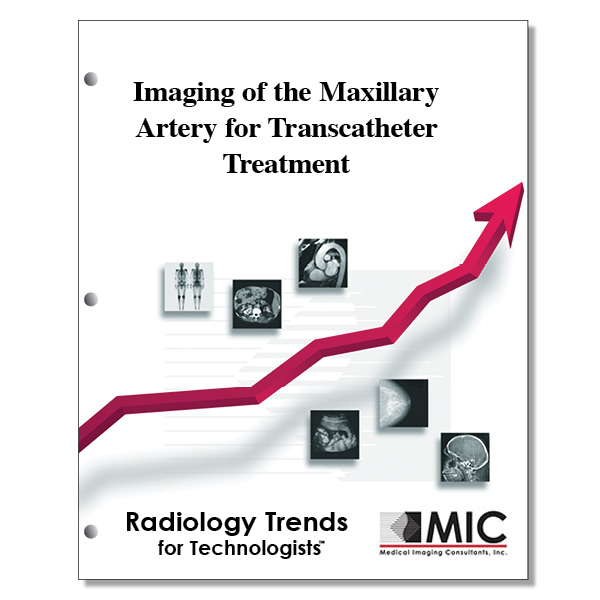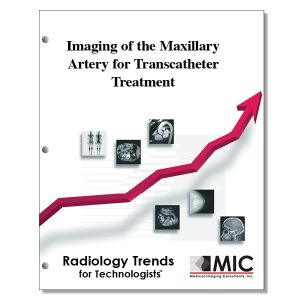

Imaging of the Maxillary Artery for Transcatheter Treatment
A review of the CT and angiographic appearance of the maxillary arteries and endovascular techniques for the treatment of lesions.
Course ID: Q00402 Category: Radiology Trends for Technologists Modalities: CT, Vascular Interventional3.0 |
Satisfaction Guarantee |
$34.00
- Targeted CE
- Outline
- Objectives
Targeted CE per ARRT’s Discipline, Category, and Subcategory classification for enrollments starting after April 6, 2023:
[Note: Discipline-specific Targeted CE credits may be less than the total Category A credits approved for this course.]
Computed Tomography: 2.00
Procedures: 2.00
Head, Spine, and Musculoskeletal: 2.00
Magnetic Resonance Imaging: 1.50
Procedures: 1.50
Neurological: 1.50
Registered Radiologist Assistant: 3.00
Procedures: 3.00
Neurological, Vascular, and Lymphatic Sections: 3.00
Vascular-Interventional Radiography: 3.00
Procedures: 3.00
Vascular Diagnostic Procedures: 1.75
Vascular Interventional Procedures: 1.25
Outline
- Introduction
- Embryologic Features of the ECA and Maxillary Artery
- Development of the Primitive Aortic Arches
- Development of the Carotid Arteries
- Development of the ECA and Maxillary Artery
- Functional and Imaging Anatomy of the Maxillary Artery
- Normal Anatomy of the Main Trunk of the Maxillary Artery
- Origin
- First (Mandibular) Segment
- Second (Zygomatic or Pterygoid) Segment
- Third (Pterygopalatine) Segment
- Anatomy of the Pterygopalatine Fossa Relative to the Pterygopalatine Segment
- Normal Anatomy and Imaging Appearances of the Maxillary Artery Branches
- Ascending Cranial and Intracranial Branches
- Ascending Extracranial Muscular Branches
- Descending Branches
- Anterior Branches
- Recurrent Branches
- Terminal Branch
- Normal Anatomy of the Main Trunk of the Maxillary Artery
- Endovascular Treatment of Maxillary Artery Branches with Emphasis on Their Functional Anatomy
- Transarterial Embolization for Lesions Fed by the MMA and AMA
- TAE of Dental Arteries
- TAE of the Palatine Arteries
- TAE of the Infraorbital Artery
- Conclusion
Objectives
Upon completion of this course, students will:
- explain the origin of the maxillary artery
- understand variations in the maxillary artery
- name the pairs of primitive aortic arches during embryologic development
- express the regression of the primitive aortic arches during embryologic development
- understand the appearance of the third aortic arch as it pertains to embryologic development
- explain the stapedial artery divisions during embryologic development
- be familiar with the Vidian anastomotic system arteries
- know the two terminal branches of the external carotid artery
- list the segments of the maxillary artery
- understand the transition between the first and second branches of the maxillary artery
- state the branches of the mandibular segment of the maxillary artery
- recall what areas are supplied with blood by the branches of the mandibular segment of the maxillary artery
- explain the function of the lateral pterygoid muscle
- understand the percentage of cases where the second segment of the maxillary artery takes a superficial route
- describe the features of the pterygopalatine segment of the maxillary artery
- associate the areas supplied by the pterygopalatine segment of the maxillary artery with their respective branches
- describe the shape of the pterygopalatine fossa
- list the borders of the pterygopalatine fossa
- state the anatomic structures within the pterygopalatine fossa
- know how maxillary artery branches are classified
- understand which artery supplies the external auditory canal
- explain what may occur if the middle meningeal artery ruptures
- recall the divisions of the middle meningeal artery after exiting the foramen Spinosum
- communicate what angiographic views are helpful in distinguishing between the petrosquamosal and petrosal arteries
- know the meaning of the Latin term “foramen ovale”
- summarize the arterial blood supply for the temporal muscle
- know the origin of the four descending branches of the maxillary artery
- list the anterior branches of the third segment of the maxillary artery
- specify the path of the sphenopalatine artery
- specify the major feeding artery of dural arteriovenous fistula
- list the symptoms of dural AVFs
- explain the blood flow in patients with an AVF
- state the arteries responsible for uncontrolled bleeding after molar extraction
- express the arteries that feed tumors of the nasopharyngeal region
- be familiar with the most common benign and malignant orbital tumors
